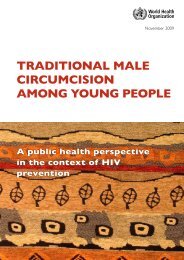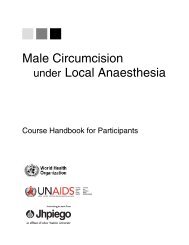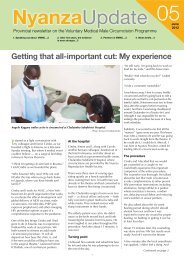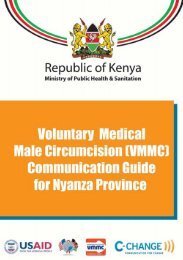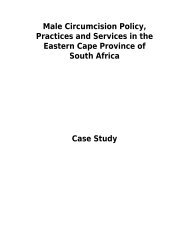Manual for Male Circumcision under Local Anaesthesia
Manual for Male Circumcision under Local Anaesthesia
Manual for Male Circumcision under Local Anaesthesia
You also want an ePaper? Increase the reach of your titles
YUMPU automatically turns print PDFs into web optimized ePapers that Google loves.
<strong>Male</strong> circumcision <strong>under</strong> local anaesthesia Version 2.5C (Jan08)<br />
PREFACE<br />
<strong>Male</strong> circumcision has been per<strong>for</strong>med on boys and young men <strong>for</strong> many years, primarily <strong>for</strong><br />
religious and cultural reasons or as a rite of passage to mark the transition to adulthood.<br />
Data from cross-sectional epidemiological studies conducted since the mid-1980s showed<br />
that circumcised men have a lower prevalence of HIV infection than uncircumcised men.<br />
This finding was supported by data from prospective studies that showed a lower incidence<br />
of HIV infection in circumcised men than in uncircumcised men. Although the analysis<br />
adjusted <strong>for</strong> cultural and social factors associated with male circumcision, it was not clear<br />
from these studies whether promoting male circumcision among men who would not<br />
otherwise be circumcised would result in a lower incidence of HIV infection. To address this<br />
question, three randomized controlled trials were launched in Kenya, Uganda and South<br />
Africa in 2004. The results from the South African study were published in late 2005, and<br />
showed a 60% lower incidence of HIV infection among men randomly assigned to <strong>under</strong>go<br />
immediate circumcision compared with those assigned to delayed circumcision.<br />
Confirmatory results from the two other trials were released in December 2006. A further<br />
trial, which is assessing the impact of male circumcision on the incidence of HIV infection in<br />
female partners, is <strong>under</strong>way, but is not expected to provide results be<strong>for</strong>e end 2008.<br />
There is increased demand <strong>for</strong> male circumcision in several countries with a high incidence<br />
of HIV, but there is little technical guidance on how services can be safely expanded given<br />
the limited resources available. Reports of high complication rates following circumcisions<br />
per<strong>for</strong>med on young men by traditional circumcisers in southern and eastern Africa are<br />
common, but the true incidence is not known. Technical guidance on the provision of safe<br />
male circumcision services is there<strong>for</strong>e necessary. Although circumcisions are widely<br />
per<strong>for</strong>med by surgeons and general practitioners in an appropriate clinical environment,<br />
resources are not currently adequate to meet the anticipated increased demand.<br />
This technical manual on male circumcision is aimed at providers of male circumcision<br />
services and programme managers. No attempt is made to describe all possible methods <strong>for</strong><br />
male circumcision. The methods covered have been selected on the basis of their safety and<br />
practicality <strong>for</strong> use in resource-limited settings. The manual <strong>for</strong>ms part of a comprehensive<br />
package, which includes training guides and materials, as well as a male circumcision<br />
quality improvement framework <strong>for</strong> use by providers, programme managers and national<br />
medical authorities to ensure high-quality services. While providing detailed technical<br />
in<strong>for</strong>mation on the different surgical approaches, the manual also addresses broader issues<br />
of sexual and reproductive health of men, and emphasizes that male circumcision must be<br />
set within the context of other strategies <strong>for</strong> reducing risk of HIV infection. A full description<br />
of best practices <strong>for</strong> surgery and anaesthesia in resource-limited settings can be found in the<br />
WHO publication, Surgical care at the district hospital (Geneva, WHO, 2003).<br />
The manual has been developed by the World Health Organization (WHO), in collaboration<br />
with the Joint United Nations Programme on HIV/AIDS (UNAIDS) and JHPIEGO, as part of<br />
work to support countries in providing safe male circumcision services, and ensuring that<br />
circumcised men do not perceive themselves as fully protected against HIV and other<br />
sexually transmitted infections and consequently <strong>for</strong>go other HIV risk-reduction strategies.<br />
The manual was developed from reproductive health and surgery training materials, as well<br />
as on the basis of experience with service provision in Africa, the Eastern Mediterranean,<br />
and developed countries. The manual and materials were reviewed by actual and potential<br />
providers of male circumcision services representing a range of health care and cultural<br />
settings where demand <strong>for</strong> male circumcision services is high.<br />
Page vii<br />
<strong>Male</strong> circumcision <strong>under</strong> local anaesthesia Version 2.5C (Jan08)<br />
ACKNOWLEDGEMENTS<br />
This manual is based on the work of a large group of clinical and public health experts who<br />
participated in technical consultations and reviews. Particular thanks are due to the<br />
following:<br />
- Tim Hargreave and Emmanuel Otolorin who wrote and edited the draft manual;<br />
- the Orange Farm, Kisumu and Rakai study teams, who generously shared slides, videos<br />
and training materials;<br />
- Robert Bailey, Palesa Mohaleroe, Emmanuel Otolorin and Stephen Watya <strong>for</strong><br />
photographic illustrations;<br />
- Oheneba Owusu-Danso and Kwabena Danso <strong>for</strong> photographs and a description of the<br />
Gomco clamp method, from which the illustrations were made;<br />
- Bill Mansen and John Orr <strong>for</strong> review of Chapter 7;<br />
- Micheline Diepart, Gerald Dziekan and Selma Khamassi <strong>for</strong> review of Chapter 8;<br />
- Gillian Kidd, Department of Medical Illustration, University of Edinburgh, Scotland who<br />
prepared the illustrations of the surgical methods;<br />
- Melanie Bacon, Robert Bailey, AS Chawla, Han-Sun Chiang, Kelly Curran, Adam<br />
Groeneveld, John Krieger, Jasper Nduasinde, Redouane Rabii, and Stephen Watya<br />
who provided detailed written comments on the manual;<br />
- Joanne Ashton, Joint Commission International;<br />
- Bertran Auvert, Melanie Bacon, Kasonde Bowa, Dy Bun Chhem, Kelly Curran, Adam<br />
Groeneveld, Tim Hargreave, Chris Heyns, Martin Kaluwaji, Sifuni Koshuma, Chiapo<br />
Lesetedi, Palesa Mohaleroe, Samuel Mutamba, Jasper Nduasinde, John Opeya Oloo,<br />
George Shawi Shilaluke, Ajit Sinha, B.S. Toma, Stephen Watya and Charles Wiysonge<br />
who participated in a technical review of the draft manual in Montreux, Switzerland, in<br />
April 2006; and<br />
- Khalil Abu-Dalu, Adam Abzak, Yona Amitai, Zahavi Cohen, Cyril Fine, Esther Galili,<br />
Benjamin Gesundheit, Debby Gedal-Beer, Eitan Gross, Mordechai Halperin, Pinhas<br />
Livne, Yoram Mor, Neil Perlman, Hanni Rosenberg, Inon Schenker, Francis Serour, Eli<br />
Simhi and Moshe Westreich, <strong>for</strong> detailed review and comments during a technical<br />
meeting in Jerusalem, Israel, in December 2006, facilitated by the Jerusalem AIDS<br />
Project.<br />
The technical content of the manual has been reviewed by representatives of the Pan-<br />
African Urological Surgeon’s Association (PAUSA), the Korean Andrology Society, the<br />
Taiwan Andrology Society, and the Israeli Association of Paediatric Surgery.<br />
The development of the manual was coordinated by Tim Farley and Manjula Lusti-<br />
Narasimhan (WHO Department of Reproductive Health and Research), Isabelle de Zoysa<br />
(WHO Family and Community Health Cluster), Kim Dickson and George Schmid (WHO<br />
Department of HIV and AIDS) Meena Cherian (WHO Department of Essential Health<br />
Technologies), and Cate Hankins (UNAIDS). Final technical editing and layout were<br />
<strong>under</strong>taken by Pat Butler and …, respectively.<br />
Page viii





